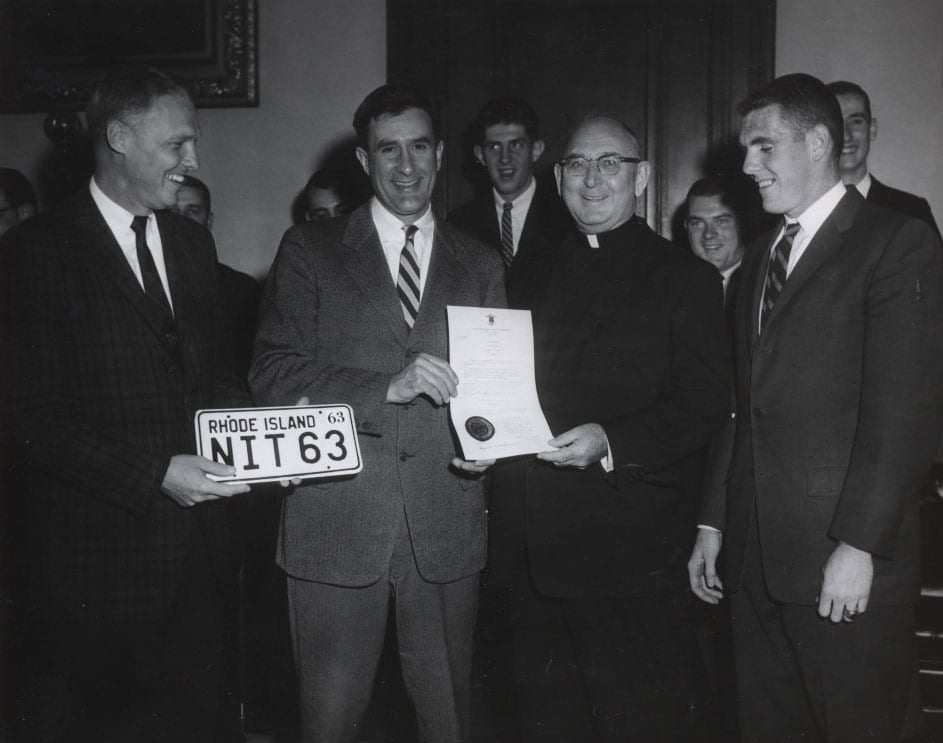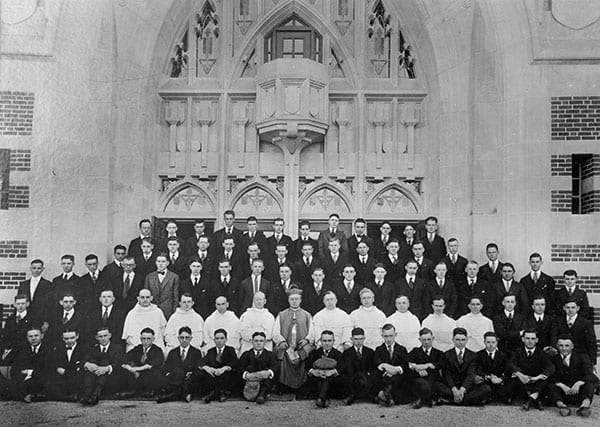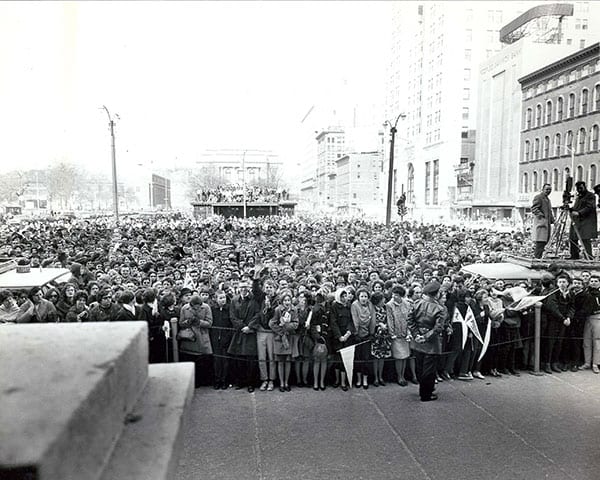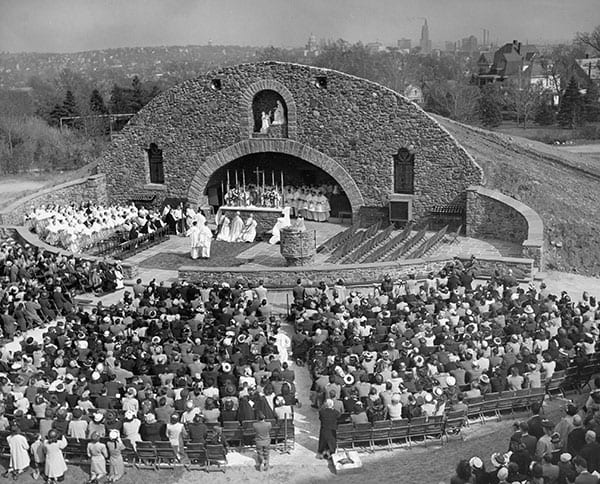A Brief History of Providence College
A New York City native drawn to Providence College by the love and example of her uncle, Rev. Cornelius P. Forster, O.P., Dr. Donna T. McCaffrey ’73G, ’83 Ph.D., & ’87G was a seminal figure in the history of the College — the same history she chronicled so fondly and scrupulously. Her 522-page doctoral dissertation, “The Origins and Early History of Providence College Through 1947,” described in vivid detail the people and the events that aligned a century ago to realize the bold vision of the Right Rev. Matthew Harkins, D.D., Bishop of Providence to build a Catholic college in the diocese. Dr. McCaffrey had a significant impact on generations of Providence College students, both as a faculty member and as a residence director who helped integrate women into the student population in 1975. This brief version of her dissertation was published in 1992, on the occasion of the 75th anniversary of the founding of Providence College.
Dr. McCaffrey died in January 2016, at the age of 66.
At 4:00 p.m. on the afternoon of March 10, 1917, the first Providence College Corporation meeting was held at the Bishop’s House. The Corporation received a land grant of eighteen acres from the Bishop and $10,000. Father Meagher pledged the Dominican teachers and $25,000 to start the first building. Harkins brought his idea to his people. A wave of enthusiasm over the prospect of a Catholic college swept over the state of Rhode Island. Many wealthy Catholics contributed to Harkins’ fund-raising program to raise $200,000, but the bulk of the donations came from those of modest means – the poor classes of laboring Catholic immigrants giving beyond what they could afford. Added to the major fund-raising efforts were a host of other events such as rummage sales and bake sales of Irish soda bread and Italian cannoli. By May 23, 1918, $156,139.73 was raised, and ground was broken for the first building – Harkins Hall (Bishop Harkins would not allow the college to be named after himself).
World War I held up the opening for a full year. Then, on May 25, 1919, the dedication of the new college coincided with Bishop Harkins’ fiftieth anniversary of ordination. On September 18, 1919, with seventy-one students and nine Dominican faculty, Providence College opened her doors, pledged to a particular educational system. This pedagogy was basically “the scholastic system, adapted from Aristotle and the Ancient Greeks, Christianized by Thomas Aquinas and Albertus Magnus, and successfully carried out by the Order of Preachers for seven centuries in the great universities.”
In the line of Dominic, Fenwick, Harkins, and Meagher, for the next seventy-five years Providence College grew and prospered. Early Presidents, Albert D. Casey, O.P. (1919-1921); William D. Noon, O.P. (1921-1927); Lorenzo C. McCarthy, O.P. (1927-1936); John J. Dillion, O.P. (1936-1944); Frederick C. Foley, O.P. (1945-1947) guided Providence College through her youthful, struggling early history. Providence College overcame the obstacles raised by World War I, survived the Great Depression and plummeting enrollment caused by World War II. The college grew from eighteen to forty-five and a half acres, from one building to seven, and produced approximately 2,500 alumni by 1947.
From nine Dominicans in 1919 to eighty-six laboring by 1947 and from one layman in 1927 to approximately eighteen laymen in 1947, the faculty ranks swelled to implement a curriculum leading to degrees of Bachelor of Arts, Bachelor of Philosophy, Bachelor of Science, or a Two-Year Medical Certificate meeting the then requirements of the American Medical Association. Prior to the official opening of the college in 1919, Dominican faculty taught the first credit-bearing PC courses to women religious in 1918. These “night school” students pursued degrees throughout the first five presidential tenures and firmly entrenched the college’s commitment to church and community service through the division of continuing education.
Finances played a large role in determining the physical growth of the college through World War II. Bishop Harkins’ initial fund drive was augmented by Bishop Hickey’s 1920 diocesan drive, Father Dillon’s 1937 Aquinas Hall drive, and Father Foley’s 1947 $1.5 million building fund. The financial generosity and broad support of the Catholics of Rhode Island saw the college through the Great Depression and World War II. All gifts were sought and none overlooked. The most unusual donation, a first in PC history, came when a young fifteen-year-old MGM film star sold “her autograph in front of the Loew’s State Theater” for five and ten dollars a copy on February 18, 1938. The next day, at a Bridge and Fashion show in Harkins Hall, Ms. Judy Garland, not yet of Wizard of Oz fame (1939) “came bearing gifts” to Father Dillon’s Aquinas Hall fund. In appreciation, Ms. Garland, “a girl with a gift, was laden with roses,” by attentive PC students.
Fundamental to all five presidencies was the Catholic identity of the college, the retention of the seven-hundred-year-old scholastic nucleus, a strong commitment to liberal arts, and a successful adaptation to the trends of higher education set by regional and national accrediting associations. The idea of the founders, a Catholic college in Rhode Island, came of age.
From the solid foundations laid in the first thirty years, Providence College matured into a modern, fully accredited Catholic liberal arts college under the next five presidencies of Robert J. Slavin, O.P. (1947-1961); Vincent C. Dore, O.P. (1961-1965); William P. Haas, O.P. (1965-1971); Thomas R. Peterson, O.P. (1971-1985); and John F. Cunningham, O.P. (1985 to the present).
The later Dominican presidents, committed to the idea of the founders and early fathers, carried the college forward through adversity, economic crisis, national decrease in all-male college enrollments, the Korean War, the Vietnam War, oil embargoes, the civil rights and students’ rights movements of the sixties, admission of women in 1971, the declining number of American clergy, the tragic death of ten women in the Aquinas Dormitory fire of 1977, the blizzard of 1978, and the Persian Gulf War.
Rev. Robert J. Slavin, O.P., fostered new post-World War II vision of unlimited horizon for the growth and development of Providence College. Stately, handsome, imperial, exuding an aura of authority, competence, and brilliant leadership, Father Slavin sought to bring Providence College to new heights in academia.
Under Father Slavin’s tenure, the Albertus Magnus science building, Alumni Hall Gymnasium, and Raymond Hall dining/ dormitory complex were built.
Providence College first joined the Eastern College Athletic Conference and in 1948 the National Collegiate Athletic Association (NCAA). In March 1961 Providence College men’s basketball team won their first National Invitational Tournament, dazzling the crowds in New York City’s Madison Square Garden and bringing Providence College national athletic recognition.
With Father Slavin’s strong approval, Rev. Charles H. McKenna, O.P., energetically raised funds and built the War Memorial Grotto—Providence College’s eternal tribute to remain forever a reminder of her sons who fought and died in American conflicts.
Father Slavin continued to foster Providence College’s growth in every opportunity and mode he could envision. WDOM began broadcasting in April 1949. The first and innovative Summer School of Theology for Religious Women started classes in 1950. Providence College granted degrees in 1955 to students of the college affiliated with Cardinal Cushing School of Theology for Laity.
With student enrollment growth, divisions of old departments were made to form separate Biology, Chemistry, Physics, History, and Political Science departments. A Liberal Arts Honors Program for gifted students began in 1957. Stephen and Joseph Halls were opened after extensive remodeling of the newly acquired Good Shepherd property. When faculty, friends, students, and the State of Rhode Island mourned his death on April 24, 1961, Robert Slavin’s indelible mark raised Providence College to new horizons of excellence and national recognition.
In 1961, Rev. Vincent C. Dore, O.P. succeeded Father Slavin at the beginning of one of America’s most turbulent and uneasy decades. A gentleman of unlimited kindness, a humanitarian, Father Dore came to Providence College with the first class of 1923 and held almost every major position at the college prior to becoming the seventh president. His sobriquet, “Mr. P.C.,” was apt. With an unflappable disposition and an astute eye to fiscal stringency, Father Dore led Providence College for the next four years.
During his tenure, Father Dore broke ground for Guzman, Meagher, and McDermott (the latter two paid from cash flow without loans). Children of the Great Depression, Father Dore and Treasurer Father Fennell believed in building only what you could pay for. Father Dore also dedicated the Edward J. Hickey Laboratory Building. Providence College captured its second NIT tournament in 1963, played in its first NCAA Basketball Tournament in 1964, and went to NCAA Final Four in hockey, 1964. Father Dore encouraged the growth of the graduate program, secured additional student aid with the implementation of the Federal College Work Study program, and hosted such dissident college guests as Bishop Fulton Sheen and Peter, Paul, and Mary in Junior Ring Weekend Concert for the special gift-giving Class of 1964.

A member of numerous civic boards, Father Dore was Providence College personified to the state of Rhode Island. Father Dore was appointed Chancellor in 1965, a position he held until his death in December 1984. He was also the first Dominican to be buried from the new priory.
In 1965, young, dynamic Rev. William Paul Haas, O.P., artistic, cultured, imbued with administrative acumen and the sage wisdom of a philosopher, became the eighth president of Providence College. The college was at a physical, fiscal, and academic crossroads. Volatile national issues of civil rights, student rights, and U.S. involvement in Vietnam loomed while Providence College faced diminishing clerical teaching faculty, and professionalizing of collegiate institutions.
Father Haas immediately committed significant funding to improving the College’s existing buildings/property and long-range funding for increased physical plant.
Providence College purchased the Elmhurst Academy property in 1966 and leased the nurses’ dormitory (now Fennell Hall) from the city of Providence in 1968 to encourage enrollment growth via resident students. Major construction resulted in a high-rise nontraditional ten-story dormitory, Phillips Memorial Library, and the Slavin Center Student Union. Father Haas weathered student unrest, successfully assuaging a 1967 student hunger strike and dress code challenge, a 1970 Kent State/Vietnam student strike, and a 1971 student takeover of the library. Treating students with dignity and respect, Father Haas steered Providence College through a stormy period that had wrecked many U.S. universities with violence and destruction. His tenure increased lay faculty and faculty involvement in Providence College. The first Faculty Senate meeting, first lay vice president, first lay faculty in the Departments of Religious Studies and Philosophy, the first full-time undergraduate woman faculty member, the first Committee on Academic Rank and Tenure, the first Providence College Chapter of AAUP, and the Providence-in-Europe Program in Fribourg, Switzerland, were all initiated under the tutelage of William P. Haas, O.P.
The president embodied current educational trends at Providence College substantially and symbolically. Diplomas were issued in English, a College Mace was forged, a freshman parents’ weekend was inaugurated, a summer freshman orientation program was started, tuition was raised substantially, dress codes were abolished, a summer art and art history program in Italy began, and amidst great faculty and alumni controversy, Father Haas petitioned the Corporation and received the approval for Providence College’s undergraduate day school to admit women students in the fall of 1971.
The innovation and changes wrought so successfully were not without substantial faculty, alumni, and some student opposition. For personal reasons, Father Haas petitioned Rome for laicization from the priesthood and tendered his presidential resignation effective July 1971. Secular news and media attempted to concoct a scandal. Father Haas remained at Providence College for 1971-72, teaching and guest lecturing, until official canonical laicization approved his retirement from the priesthood. His controversial presidency effectively laid a solid modernized foundation for the next “builder President.”
Thomas R. Peterson, O.P., became the ninth president in July 1971. The serene countenance, ready smile, and affable disposition belied a Viking tiger, ferocious in fostering both Providence College tradition and innovation.
A gargantuan building program directed toward academic and athletic improvement was immediately begun. In his first year, ground was broken for a self-contained hockey arena. As of 1972 men’s varsity basketball games were moved to the Providence Civic Center. Three new outdoor athletic fields were added by 1976, and by 1981 a comprehensive field house was completed. In addition, from his inauguration on, the “builder President” cautiously, sagely, and with unmatched diplomacy negotiated the purchase of the adjacent Chapin Hospital property.
In his fourteen-year tenure, he effectively refurbished all the facilities on the new east or “lower campus.” Completed were Dore Hall Dormitory, Hunt/Cavanagh Art Building, Physical Plant Storage and Garages, a ceramics center, East Hall, the first dormitory designed for women by a woman, Koffler Business Building, a Student Service/Recreation Building, Howley Social Science Classroom and Office Building, Saint Catherine of Siena Music and Performing Arts Building, and Fennell Hall Dormitory – all with adjacent parking lots!
To complete his building task, Father Peterson secured the donations to build a Dominican Faculty Residence, and in August 1984 the Dominicans, after sixty-six years of limited and inadequate housing, moved from fourth-floor Harkins (immediately converted to include a new Computer Center) to the St. Thomas Aquinas Priory, Gragnani Dominican Center.
Despite the time-consuming building program, Father Peterson, with his astutely appointed vice presidential cabinet, moved the college to new academic and national heights. Coeducation was successfully fostered with equal and integrated women’s priorities in tenured faculty, sports programs, housing appropriations, administration, approval and encouragement of female student elections to Cowl Editor, Yearbook Editor, and Student Congress President.
New departments, increased lay and Dominican Faculty, entrenching of the Core Curriculum Development of Western Civilization, founding of the Quirk Institute of Industrial Relations for a Labor-Management Studies Program, a five-year liberal arts and engineering program with the University of Notre Dame, a $25 million capital fund-raising campaign, an innovative central heating and coal conversion plant, institution of Oktoberfest and Community President’s Day, hosting of nationally renowned figures such as James E. Cheek, Howard University President, Gerald Ford, Melvin Laird, John Dean, Bruce Springsteen, Ralph Nader, Commodore Grace Hopper, Vice President Walter Mondale, Christopher Dodd, Carl Yastrzemski, Arthur Fiedler, unionizing of physical plant workers, student representation on the Corporation, and myriad activities attested that the Peterson tenure was a new era at Providence College. Student population soared. Providence Diocese seminary students received their undergraduate degrees at Providence College. By 1979, Providence College attracted more out-of-state than Rhode Island students, and women outnumbered men in the freshman class. Tuition rose appropriately, and more students enrolled from parental college-degreed families.
In all, the Peterson era was a Camelot of growth and development academically, fiscally, and physically. The devastating Aquinas fire of December 13, 1977, took the lives of ten Providence College women, traumatized the Providence College community and the state of Rhode Island, and was garishly ranked in the “top 10 news stories” of the decade. What could have destroyed the college turned from defeat to victory. The heroic paternal concerns of Thomas R. Peterson, O.P. led mourning, shocked student, faculty, and administrative groups to a new familial consciousness. From grief, the “PC Family” emerged.
When Father Peterson passed the mace to the tenth president, Providence College was at a breathtaking plateau of excellence. Providence College was emerging as a Catholic liberal arts college of small-university stature.
A native Rhode Islander, former academic dean, former assistant provincial, satirical wit, philosopher, and thespian, John F. Cunningham, O.P., was inaugurated president in September 1985.
Reevaluation, redirection, new staffing, scrutiny of curriculum, preparation for the seventy-fifth anniversary, and Providence College’s entrance into the twenty-first century became the themes of Father Cunningham’s program.
Immediate physical growth needs were addressed through: ground-breaking for the Sowa Science Building Connector, construction of three apartment student residence complexes, rebuilding of Antonius Hall into the Western Civilization Program Center of Moore Hall, dedication of a Vietnam War Memorial and a contemplative tree grove in memory of Walter J. Heath, O.P., construction of an off-campus housing building, refurbishing of the old Good Shephard barn into the O’Reilly Infirmary and Security Building, relocation of Physical Plant to lower campus, refurbished storage building, and continued renovation of the former physical plant and the last Chapin property buildings.
A major capital fund-raising campaign is ongoing to procure further needed classrooms, dormitories, and office buildings. In academic enrichment, a President’s Speakers’ Series, an Asian Studies Program, expanded student opportunity for study abroad, the institution of academic minors to enhance student learning and post-graduation competitiveness all attest to Father Cunningham’s presidential program. Far-sighted, his reevaluation of the Catholic identity of the college and his Plan Providence 2000 are laying the foundation of Providence College’s growth and development toward further excellence.
The Post-World War II presidents have collectively moved Providence College into the national arena. The labors of these presidents culminated in national academic recognition for the college. In 1991, Providence College was ranked by The National Review among America’s fifty top liberal arts colleges, and in 1990 by Barron’s as one of the three hundred best buys in the United States. Additionally, the U.S. News and World Report of September 30, 1991, listed Providence College sixth in the Regional Colleges and Universities category.
In the past forty-five years, the Providence College campus grew to approximately 105 acres with the addition of the adjacent Sisters of Good Shephard property and the Chapin Hospital property. Through the arduous procurement of funds from loyal alumni, capital fund campaigns, loans, and the continued contributed service of Dominican administrators and faculty, the expansion of the campus mission to higher education was achieved.
By 1992, Providence College grew to over fifty-four facilities, including administration and classroom buildings, a science complex, an award-winning library with approximately 300,000 holdings, an art building, music building, Dominican residence, fourteen student residences, three athletic buildings with pool, ice rink, and indoor courts and track, five indoor and one outdoor chapel, a student recreation center, two cafeterias, and eleven parking areas! This impressive physical plant is self-contained in a visually evocative park-like setting located in the midst of a thriving New England city.
In 1991, the 287 teaching faculty members consisted of 217 full-time and seventy visiting and adjunct professors, including forty Dominican Fathers and eight Dominican Sisters. Over 73 percent hold doctorates. Over thirty-seven academic majors and programs for approximately 3,800 undergraduate students lead to the Bachelor of Arts and Bachelor of Science degrees.
The scholarly milieu and academic community is enhanced by a growing Graduate School. Proposed in 1963 and nurtured and guided by Cornelius P. Foster, O.P., the Graduate School enrolls approximately six hundred students yearly. Since 1964, over 3,772 students have been awarded an M.A., M.S., M.Ed., M.B.A., or Ph.D. from the Graduate School of Providence College.
Serving the community of full time working people, newer immigrant groups, the Catholic Diocese of Providence, and those purely interested in pursuing personal intellectual enrichment, the School of Continuing Education remains the oldest division of Providence College. From 1925-1992, 2,393 students have been awarded degrees and certificates through the Providence College evening division, officially designated the School of Continuing Education as of 1972.
Poised on the threshold of the third millennium, 29,632 alumni bear the impress of Providence College as an indelible mark on their character and service in society.
Nearly seventy-five years ago, when Bishop Thomas Shahan addressed the crowd on that Sunday afternoon dedication of Harkins Hall, he told the crowd how fortunate they were to have the Dominicans as the teachers for the new college. He also predicted that, under their guidance and care, now augmented by a dedicated lay faculty:
From these walls must one day go forth the young [people] destined to take the places of the faithful and laborious priests who now toiled daily for your spiritual welfare, the cultivated teachers and public speakers who will expound and defend the interests of the Catholic Religion, the writers of all kinds, poets, historians, philosophers without whom no society is honored, the journalists of courage and honest who are the watchdogs of liberty, the physicians and the lawyers whose ancient professions demand a very high degree of liberal learning.
How very astute were Thomas Shahan’s predictions. His hope became the reality that is Providence College. People with an idea, with courage, with belief in God, and the pursuit of truth have sacrificed to realize this educational idea. As Senator John O. Pastore remarked to then-Vice President Walter Mondale in 1978, “Providence College has wrought a social and intellectual revolution in the State of Rhode Island” – and, as we have seen, from this state unto the nation.








